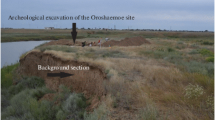Abstract
The study of soils of different ages in different physiographic regions of the Crimean Peninsula made it possible to reveal the main regularities of pedogenesis in the Late Holocene (in the past 2800 years). With respect to the average rate of the development of soil humus horizons, the main types of soils in the studied region were arranged into the following sequence: southern chernozems and dark chestnut soils > mountainous forest brown soils > gravelly cinnamonic soils. In the newly formed soils, the accumulation of humus developed at a higher rate than the increase in the thickness of humus horizons. A sharp decrease in the rates of development of soil humus profiles and humus accumulation took place in the soils with the age of 1100-1200 years. The possibility for assessing the impact of climate changes on the pedogenetic process on the basis of instrumental meteorological data was shown. The potential centennial fluctuations of the climate in the Holocene determined the possibility of pulsating shifts of soil-geographic subzones within the steppe part of the Crimea with considerable changes in the rates of the development of soil humus horizons in comparison with those in the Late Holocene.
Similar content being viewed by others
References
A. L. Aleksandrovskii and E. I. Aleksandrovskaya, Soil Evolution and the Geographic Environment (Nauka, Moscow, 2005) [in Russian].
V. F. Val’kov, K. Sh. Kazeev, and S. I. Kolesnikov, Soils in the South of Russia (Everest, Rostov-on-Don, 2008) [in Russian].
M. F. Veklich, Problems of Paleoclimatology (Naukova dumka, Kiev, 1982) [in Russian].
V. R. Volobuev, Introduction to the Energetics of Soil Formation (Nauka, Moscow, 1974) [in Russian].
A. N. Gennadiev, Soils and Time: Models of Development (Izd. Mosk. Gos. Univ., Moscow, 1990) [in Russian].
P. V. Goleusov, F. N. Lisetskii, and O. A. Chepelev, “Soil Development in the Steppe Zone (from the Results of Studying Surfaces of Different Ages in the Bosporus Area),” in Cimmerian Bosporus and Barbaric World in the Antique Period and Middle Ages (Bosporskie Chteniya, no. 7, 79–84 (Kerch, 2006) [in Russian].
V. A. Demkin, Paleopedology and Archaeology: Integration of the Studies of the History of Nature and Society (ONTI PNTs RAN, Pushchino, 1997) [in Russian].
V. G. Ena, Al. V. Ena, and An. V. Ena, Landscapes Reserves in Tauris (Biznes-Inform, Simferopol, 2004) [in Russian].
V. N. Zin’ko, Chora of Bosporus Nympheus (Bosporskie Issledovaniya, no. IV (Simferopol-Kerch, 2003) [in Russian].
V. N. Ivanov, Soils of Crimea and the Improvement of Their Fertility (Krym, Simferopol, 1966) [in Russian].
I. V. Ivanov, Evolution of Soils in the Steppe Zone in the Holocene (Nauka, Moscow, 1992) [in Russian].
I. V. Ivanov and F. N. Lisetskii, “Correlation of Soil Formation Rhythms with periodicity of Solar Activity over the Last 5000 Years,” Dokl. Akad. Nauk, Earth Sci., 340(1), 189–194(1996).
A. V. Kislov, Climate in the Past, Present, and Future (MAIK Nauka/Interperiodika, Moscow, 2001) [in Russian].
Classification and Diagnostic System of Russian Soils (Oikumena, Smolensk, 2004) [in Russian].
Climate and Hazardous Meteorological Phenomena in Crimea K. T. Logvinov (Ed.) (Gidrometeoizdat, Leningrad, 1982) [in Russian].
M. A. Kochkin, “Soils, Forests, and Climate of the Mountainous Crimea and the Ways of Their Rational Use,” Nauchn. Tr. Nikitsk. Botanich. Sada, Vol. 38 (Kolos, Moscow, 1967) [in Russian].
A. A. Maslennikov, Ancient Earthy Ramparts in the Eastern Crimea (Grifi K, Tula, 2003) [in Russian].
P. D. Podgorodetskii, Crimea: Nature. Reference Book (Tavriya, Simferopol, 1988).
Field Soil Guide (Urozhai, Kiev, 1981), p. 320 [in Russian].
I. Ya. Polovitskii and P. G. Gusev, Soils of Crimea and the Improvement of Their Fertility (Tavriya, Simferopol, 1987) [in Russian].
M. I. Polupan, V. B. Solovei, V. I. Kisil’, and V. A. Velichko, Ecogenetic Status and Fertility of Ukrainian Soils (Koloobig, Kiev, 2005) [in Ukrainian].
Soils of Crimean Oblast (Krym, Simferopol, 1969) [in Russian].
Nature of the Ukrainian Republic. Landscapes and Physiographic Regionalization (Naukova dumka, Kiev, 1985) [in Russian].
Reference Book on Climate of the USSR (Gidrometeoizdat, Leningrad, 1967), Vol. 10, Parts 1–4 [in Russian].
V. O. Targulian, “Soil Memory: Formation, Carriers, and Spatiotemporal Diversity,” in Soil Memory: Soil as a Memory of the Biosphere-Geosphere-Anthroposphere Interactions (Izd. LKI, Moscow, 2008), pp. 24–57 [in Russian].
V. M. Fridland and I. I. Lebedeva, “On the Classification and Regionalization of Chernozems of Ukraine in Relation to the All-Union Soil Classification System,” in Chernozems of the USSR (Ukraine) (Kolos, Moscow, 1981), pp. 240–249 [in Russian].
C. E. Cordova and P. H. Lehman, “Holocene Environmental Change in Southwestern Crimea (Ukraine) in Pollen and Soil Records,” The Holocene 15(2), 263–277 (2005).
FAO-UNESCO Soil Map of the World. 1: 5000000. 1974-1978, 2003 // Digital Soil Map of the World and Derived Soil Properties (http://www.fao.org/AG/AGL/agll/dsmw.stm).
P. V. Goleusov and F. N. Lisetskii, “Soil Development in Anthropogenically Disturbed Forest-Steppe Landscapes,” Eur. Soil Sci. 41(13), 1480–1486 (2008).
J. W. Harden and E. M. Taylor, “A Quantitative Comparison of Soil Development in Four Climatic Regimes,” Quaternary Research 20(3), 342–359 (1983).
F. N. Lisetskii and E. I. Ergina, “Soil formation in the Mediterranean Type of Climate, South Cost of the Crimea,” Visnyk Kharkivs’k. Nats. Agrarn. Univ. im V.V. Dokuchaeva, Ser. Gruntoznav, Agrokhim., Zemlerob. Lisove Gospodarstvo, no. 2, 58–62 (2008).
Author information
Authors and Affiliations
Additional information
Original Russian Text © F.N. Lisetskii, E.I. Ergina, 2010, published in Pochvovedenie, 2010, No. 6, pp. 643–657.
Rights and permissions
About this article
Cite this article
Lisetskii, F.N., Ergina, E.I. Soil development on the Crimean Peninsula in the Late Holocene. Eurasian Soil Sc. 43, 601–613 (2010). https://doi.org/10.1134/S1064229310060013
Received:
Published:
Issue Date:
DOI: https://doi.org/10.1134/S1064229310060013



